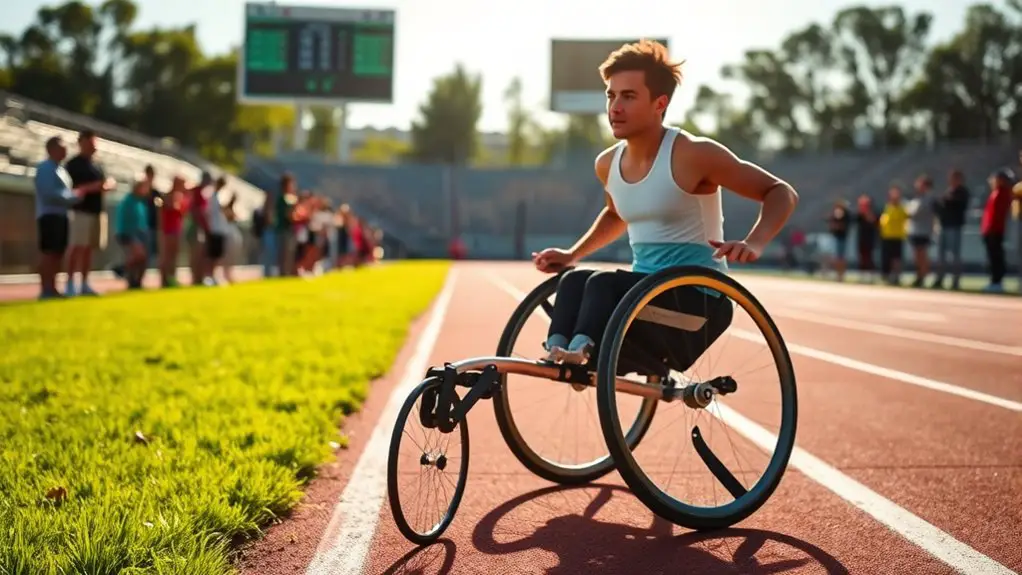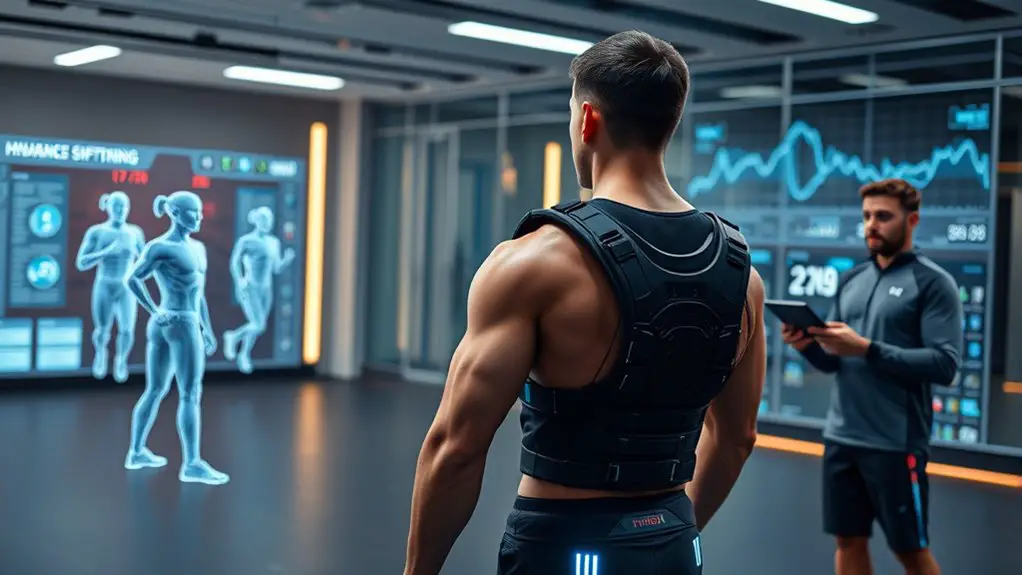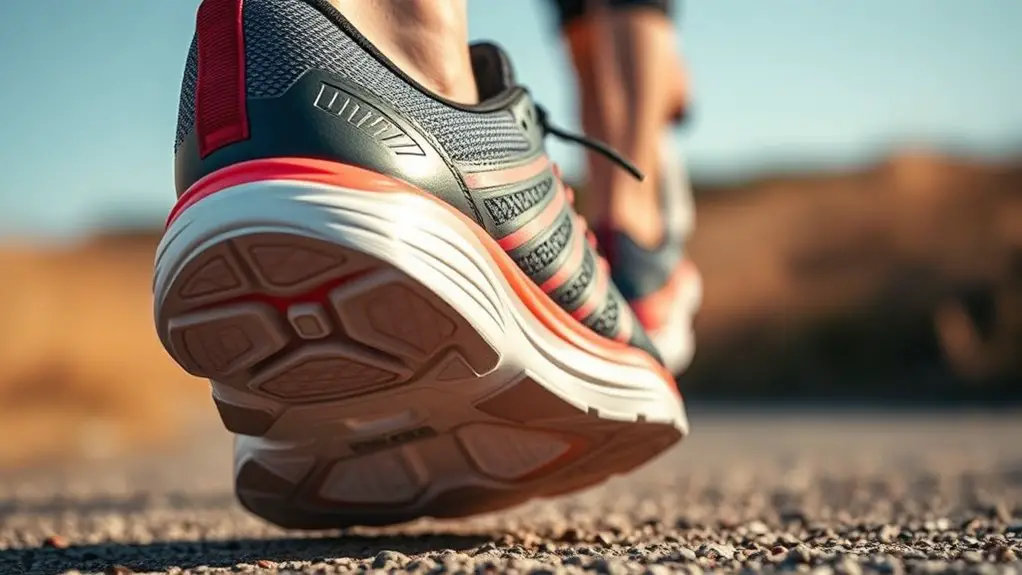Assistive technology plays a crucial role in boosting sports performance for athletes of all abilities. It empowers you to overcome barriers and chase your dreams, whether through advanced prosthetics that mimic natural movements or specialized equipment that enhances your skills. Wearable tech offers real-time feedback, helping you optimize training and prevent injuries. With innovations like virtual reality and smart sensors, the sporting landscape is becoming more inclusive. Discover how these technologies transform the way athletes compete and train.
Understanding Assistive Technology in Sports
As you explore the world of sports, you'll quickly realize that assistive technology plays an essential role in enhancing performance for athletes with disabilities. These innovations, known as assistive devices, empower individuals to break barriers and achieve their dreams. From specialized wheelchairs for racing to hearing aids that improve communication on the field, each device is designed with freedom in mind.
Adaptive strategies also play a critical role in sports. Coaches and athletes collaborate to develop personalized techniques that maximize strengths and minimize limitations. This might include unique training regimens or modified rules that allow athletes to compete effectively.
The combination of assistive devices and adaptive strategies fosters an inclusive environment where everyone can participate and excel. By embracing these tools, athletes can not only improve their performance but also inspire others to pursue their passions, proving that determination knows no bounds.
Advanced Prosthetics and Their Impact
While many people may not realize it, advanced prosthetics are revolutionizing the way athletes with disabilities compete in sports. These innovations are crafted with advanced designs, enabling users to experience newfound freedom on the field. With customizable features, athletes can tailor their prosthetics to suit their unique needs, enhancing performance and comfort.
Imagine a runner using a carbon-fiber blade that mimics the natural motion of a leg, giving them the ability to sprint alongside able-bodied competitors. Or consider a basketball player who can adjust the grip and support of their prosthetic arm for ideal shooting precision.
These developments not only empower athletes physically but also psychologically, fostering a sense of independence and possibility. As technology continues to evolve, the gap between ability and disability narrows, pushing the boundaries of what's achievable in sports. Advanced prosthetics truly embody the spirit of competition, allowing everyone to pursue their passion for sport.
Wearable Technology for Real-Time Performance Analysis
How can athletes optimize their performance in real-time? With the rise of wearable technology, you can now harness data accuracy to unleash your full potential. Wearable sensors provide real-time feedback and allow for precise athlete monitoring, helping you track performance metrics that matter most. This biometric tracking isn't just about numbers; it's about training optimization and making informed decisions on the fly.
Imagine knowing exactly how your body responds during training, giving you the freedom to adjust your regimen instantly. By using these tools, you can focus on injury prevention, ensuring that you stay in peak condition while chasing your goals. The insights gained from wearable technology empower you to fine-tune every aspect of your performance, helping you achieve that level of excellence you aim for. Additionally, the ability to monitor real-time heart rate helps you optimize your workouts and avoid potential injuries. Embrace the future of sports and let wearable technology elevate your game.
Smart Equipment and Training Tools
With the integration of smart equipment and training tools, you can enhance your training experience like never before. These innovative technologies provide real-time feedback, allowing you to fine-tune your performance and reach your goals. Smart sensors embedded in equipment track your movements and biomechanics, giving you invaluable insights. Here are some benefits you can enjoy:
- Enhanced Training Analytics: Gain access to detailed performance metrics that help you identify strengths and weaknesses.
- Personalized Workouts: Tailor your training sessions based on data-driven insights that suit your unique needs.
- Injury Prevention: Monitor your body's response during workouts to reduce the risk of injury. Additionally, these technologies utilize wearable technology to track movement and biomechanics, signaling potential injuries before they occur.
The Role of Virtual Reality in Athlete Training
Virtual reality's making waves in athlete training by creating immersive environments that mimic real competition. You can use skill visualization techniques to enhance your performance and refine your tactics. Plus, performance analysis tools in VR help you track your progress and pinpoint areas for improvement.
Immersive Training Environments
As athletes constantly seek an edge in performance, immersive training environments, particularly through virtual reality (VR), have emerged as a transformative tool. These technologies allow you to engage in immersive simulations that replicate real-life scenarios, enhancing your training experience. With digital coaching, you can receive tailored feedback in real-time, pushing your skills further.
- Experience realistic game situations without physical strain.
- Improve decision-making and reaction times in a controlled environment.
- Access personalized training regimens designed to meet your specific needs.
Skill Visualization Techniques
Immersive training environments create a perfect backdrop for skill visualization techniques, allowing athletes to mentally rehearse and refine their skills. By using virtual reality, you can engage in cognitive rehearsal, vividly simulating the pressures and scenarios you'll face in competition. This freedom to visualize your performance helps build confidence and enhances muscle memory, making the shift from mind to action smoother. Imagery techniques further allow you to picture successful outcomes, reinforcing positive behaviors and strategies. As you immerse yourself in these tailored experiences, you're not just practicing; you're embedding critical skills deep within your subconscious. Embrace this technology, and watch how it transforms your training, revealing your potential like never before.
Performance Analysis Tools
While traditional performance analysis methods have their merits, the integration of virtual reality (VR) is revolutionizing how athletes train and improve. With VR, you can immerse yourself in realistic training environments that enhance your skills and decision-making. This technology not only provides instant feedback but also allows for detailed performance metrics and data visualization, giving you insights you wouldn't otherwise have.
- Experience game-like scenarios without the pressure of competition.
- Analyze your movements and techniques in a virtual space.
- Track your progress over time with precise data.
Enhancing Accessibility in Sports
When it comes to enhancing accessibility in sports, adaptive equipment innovations play a vital role in breaking down barriers. You'll also find that inclusive sports programs and technology training initiatives are essential for fostering participation among all athletes. Together, these elements create a more equitable sports environment for everyone.
Adaptive Equipment Innovations
As adaptive equipment innovations continue to emerge, they're transforming the landscape of sports by making it more accessible for athletes with disabilities. With each advancement in adaptive devices, you'll find new opportunities to harness potential and experience the thrill of competition. These innovations not only enhance performance but also empower athletes to break barriers.
Consider these key advancements:
- Customizable wheelchairs designed for speed and agility in racing or basketball.
- Adaptive surfboards that provide stability and buoyancy, enabling individuals to ride the waves.
- High-tech prosthetics that mimic natural movement, allowing for greater participation in various sports.
With improved equipment accessibility, athletes can truly embrace their passion and redefine what's possible in sports.
Inclusive Sports Programs
The advancements in adaptive equipment pave the way for inclusive sports programs that further enhance accessibility for athletes with disabilities. With these programs, you can experience the thrill of competition without barriers. Adaptive coaching plays a significant role in tailoring training techniques to meet individual needs, ensuring everyone has the opportunity to shine. Inclusive competitions bring together athletes of all abilities, fostering camaraderie and encouraging personal growth. You'll find that these environments not only promote physical fitness but also empower participants to embrace their identities and celebrate their achievements. With the right support and resources, everyone can enjoy the freedom of sports, proving that determination knows no limits. Inclusivity in sports isn't just a goal; it's a movement toward equality.
Technology Training Initiatives
While many athletes aim for excellence, technology training initiatives are transforming how individuals with disabilities access and participate in sports. These initiatives focus on adaptive training and technology integration, ensuring everyone can realize their potential. Here's how they're making a difference:
- Innovative Equipment: Cutting-edge tools and gadgets designed for various disabilities enhance performance and boost confidence.
- Tailored Programs: Customized training regimens that focus on individual strengths help athletes thrive in their chosen sports.
- Community Support: Connecting athletes with mentors and peers fosters a sense of belonging and encourages growth.
Success Stories: Athletes Using Assistive Technology
When athletes embrace assistive technology, they often reveal new levels of performance and redefine what's possible in their sports. Take adaptive athletes like Jessica Long, who transformed her swimming career with advanced prosthetics. These technology breakthroughs allow her to glide through the water with unmatched speed, shattering records and inspiring countless others.
Another remarkable story is that of Danelle Umstead, a visually impaired skier. With the help of cutting-edge navigation technology and a dedicated guide, she conquered slopes that once seemed insurmountable. These examples show how assistive technology not only enhances performance but also empowers athletes to chase their dreams fearlessly.
The Future of Assistive Technology in Sports
As technology continues to evolve, the future of assistive technology in sports looks incredibly promising for athletes of all abilities. You'll likely see future advancements that push the boundaries of performance, allowing everyone to compete on a level playing field. With technological integration becoming more seamless, the possibilities are endless.
- Enhanced wearable devices that monitor performance metrics in real-time
- Smart prosthetics that adapt to different sports environments
- AI-driven coaching tools that tailor training regimens to individual needs
These innovations will empower athletes, offering them the freedom to push their limits and achieve their goals. Imagine a world where barriers fade, and everyone can experience the thrill of competition. The future of assistive technology isn't just about tools; it's about creating a more inclusive sporting landscape where every athlete can thrive, regardless of their challenges.
Frequently Asked Questions
How Do Athletes Choose the Right Assistive Technology for Their Needs?
Did you know that 70% of athletes report feeling more empowered when using assistive technology? To choose the right tech for your needs, start with personalized assessments to identify specific challenges. Don't forget to incorporate athlete feedback; it's essential for finding what works best for you. Remember, the goal is to enhance your performance and freedom, so explore options that truly resonate with your unique abilities and aspirations.
What Are the Costs Associated With Assistive Technology in Sports?
When considering costs associated with assistive technology in sports, it's essential to conduct a thorough cost analysis. You'll find that expenses can vary widely based on the technology's complexity and functionality. However, don't forget to explore funding options like grants or sponsorships that can ease the financial burden. Remember, investing in the right technology can enhance your performance and provide you with the freedom to excel in your sport.
Are There Any Regulations Governing the Use of Assistive Technology in Competitions?
Imagine a race where everyone's wings are clipped, and you're left to wonder about competition fairness. Regulations do exist for assistive devices, ensuring they don't grant an unfair advantage. They aim to create a level playing field, allowing athletes to soar without hindrance. These rules can vary by sport, but they're essential for maintaining integrity. So, as you prepare for competition, understanding these regulations can help you embrace both freedom and fairness in your performance.
How Does Assistive Technology Impact an Athlete's Mental Health and Motivation?
Assistive technology can greatly boost your mental health and motivation. It can enhance your performance, allowing you to push past limitations, which builds mental resilience. When you see improvements, you're likely to feel more empowered and confident in your abilities. This newfound freedom to explore your potential can ignite a passion for your sport, making it easier to stay motivated. Ultimately, it transforms challenges into opportunities for growth and success.
Can Assistive Technology Be Used for Injury Prevention in Sports?
Can assistive technology really help you prevent injuries in sports? Absolutely! By using wearable sensors, you can monitor your body's movements and detect potential risks before they lead to injury. These devices provide real-time injury assessment, helping you make informed decisions about your training and recovery. Embracing this technology not only enhances your performance but also gives you the freedom to enjoy your sport without the constant worry of getting hurt.




